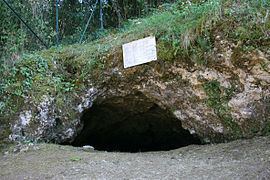Intercommunality Sud Corrézien Area 4.72 km² | Canton Beaulieu-sur-Dordogne Population (2008) 206 Local time Friday 2:18 AM | |
 | ||
Weather 3°C, Wind S at 3 km/h, 97% Humidity | ||
La Chapelle-aux-Saints is a commune in the Corrèze department in central France.
Contents
- Map of 19120 La Chapelle aux Saints France
- First discovery of a Neanderthal tomb
- Modern period
- References
Map of 19120 La Chapelle-aux-Saints, France
First discovery of a Neanderthal tomb
The La Chapelle-aux-Saints cave, bordering the Sourdoire valley, revealed many archeological artifacts belonging to the late Mousterian culture, including the first ever recognized Neanderthal burial discovered on August 3, 1908. Jean and Amédée Bouyssonie, as well as L. Bardon, led archaeological digs in the cave from 1905 to 1908, discovering over 1,000 pieces of stone industry (mainly flint), bones of different fauna including reindeer, bovid, horse, fox, wolf and even a rhinoceros’ tooth. The most spectacular discovery was that of a very well preserved skeleton of an adult Neanderthal man who appears to have been intentionally buried in a rectangular pit 30 centimetres (12 in) deep, 1.45 metres (4.8 ft) long and 1 metre (3.3 ft) wide.
This discovery led to a controversy between adversaries and partisans for the existence of tombs during the Mousterian. Arguments for the existence of a tomb were the sleeping position of the body, and the funeral "gifts" associated with the pit like stone tools and animal bones. Archaeologists believe the Chapelle-aux-Saints cave wasn’t used as a habitat, but a place for funeral feasts. One year later, at the La Ferrassie site, another Neanderthal tomb was discovered which helped to confirm the practice of entombment among Neanderthals during the middle Paleolithic.
Modern period
During the French Revolution, the commune changed its name to La Chapelle-aux-Prés following a decree from the National Convention.
